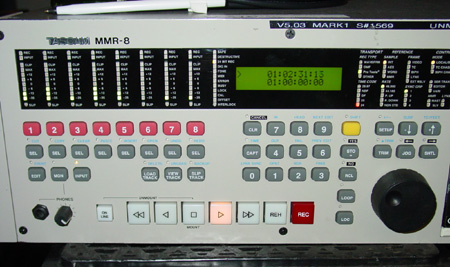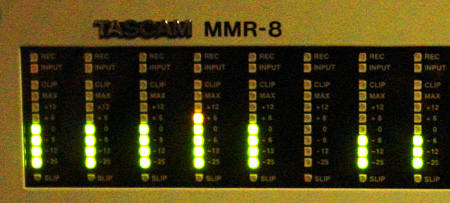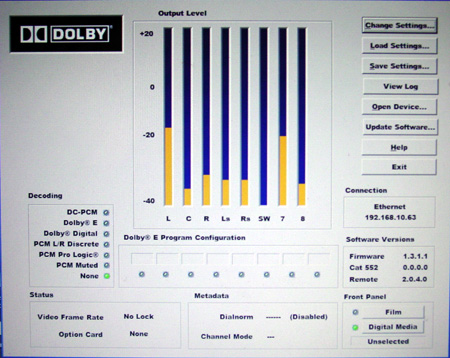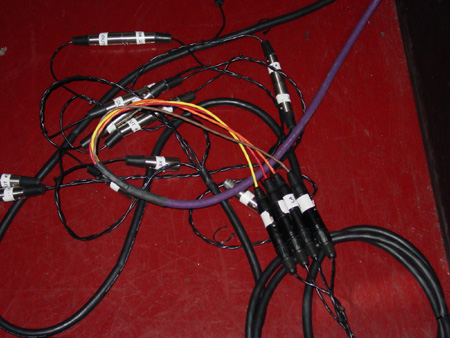Original 6-track Mix Recovered and Restored for West Side Story |
Read more at
in70mm.com
The 70mm Newsletter
|
|
Written by: Chace Audio By Deluxe Newsletter Feb 2010. Introduction by Paul Rayton |
Date: 23.02.2010 |
 Five speakers configured across the front of the Rick Chace Theatre allowed the engineer to accurately scrutinize the restored 6-track "West Side Story" as it was originally intended to be heard by audiences in 1961. Five speakers configured across the front of the Rick Chace Theatre allowed the engineer to accurately scrutinize the restored 6-track "West Side Story" as it was originally intended to be heard by audiences in 1961.
After a number of years of searching and waiting, the initial "payoff" came to the Egyptian Theatre, in Hollywood, on Wednesday, Feb. 17, 2010: The MMR-8 digital player rolled and ... to our wondering ears, we were finally able to hear, once again, and in a large venue, the full original mix of "West Side Story" in genuine 5-across, Todd-A0 format stereo!
At this point, we were listening to it without the picture. There is still a bit of polishing work to do before it's ready for a full roll-out, with the full movie. I guess there's no need to rush now -- it's only taken about 5 years (since the previous restoration work had been done) to round up the missing sound elements! How soon this will all get completed is the subject of much guesswork, since the parent MGM company (current owner of the rights) is, as this is being written, actually up for sale, and several corporate entities are considering the purchase. Failing that, the various company assets could be sold "piecemeal", so ... we all have to continue to hold our breath a bit, while it all gets sorted out. On the other hand, if you look at the calendar, you can see that 2011 is (can you believe this?!?!) the 50th anniversary of the movie. Furthermore, there is no Blu-Ray on the market yet, either. Both of these "minor details" could be very useful for big marketing pitches, so, as the saying goes, "stay tuned"...
And how did this all come about? It was definitely not easy! It was somewhat of a lonely mission, at first. After all, I was for the most part, a bit of a well-meaning but meddling "outsider" to the primary participants working on the project. I continued to pester those who were actually working with the materials to persevere, because the materials just had to be out there ... somewhere. There had been one particularly tantalizing lead as to where the missing original mag tracks might be found, which even included specific storage vault numbers. Sadly, that one location ultimately turned out to be incorrect, but Hollywood is filled with hundreds of storage vaults containing millions of rolls of stuff -- and not always correctly catalogued. That one remaining wisp of a chance of finding the tracks, along with comments from a few others who similarly were in awe of the sound of the original mix, kept me hoping, and pushing, for a positive outcome. It was far more frustrations than gratifications. As they say, much of "film restoration" is, really, just good detective work! But ... it eventually paid off, big time! Following is the description of this saga to date, as written up by the famed sound restoration company, Chace Audio, their story concerning the whole "West Side Story" project (along with a few extra photos from the audition session supplied by yours truly):
|
More in 70mm reading:
Technical
Information bulletin for "West Side Story"
Introduction to "West Side Story"
7. Todd-AO 70mm-Festival 2011
Internet link:
CHASERS
A CHACE AUDIO BY DELUXE NEWSLETTER FEB 2010
AUDIO POST, PRESERVATION, RESTORATION
& ARCHIVAL SERVICES
201 S VICTORY BLVD • BURBANK, CA 91502
(800) 842-8346 • chace.com
|
A CHACE AUDIO BY DELUXE NEWSLETTER FEB 2010 |
|
 The Tascam MMR-8 solid-state audio system. Image by Paul Rayton The Tascam MMR-8 solid-state audio system. Image by Paul Rayton
"West Side Story", the musical adaptation of William Shakespeare’s star-crossed lovers Romeo and Juliet set against the youth gang scene of New York in the 1950s, won ten Academy Awards® including best picture for producer/director Robert Wise. Released in 1961 in both 35mm and 70mm Super Panavision, the film helped to establish 6-track stereo sound for the 70mm format, yet the original ground breaking 6-track soundtrack has not been heard in the past 30 years.
According to Hollywood lore, legendary sound mixer Murray Spivak convinced director Robert Wise to adopt the new 6-track sound format L, Lc, C, Rc, R, S (Left, Left-center, Center, Right-center, Right, Surround) for the film, even though a 4-track LCRS (Left, Center, Right, Surround) mix had already been started. Wise took Spivak’s recommendation, and the result was a soundtrack that won the Oscar® for best achievement in sound. However, audiences have not heard the original Academy Award winning 6-track mix since 1981.
When a 6-track version was needed for the 20th anniversary of the film, Wise decided to create a new one from a 1978 LCRS 4-track master. This evidence was clearly indicated on the labels of the 1981 6-track mags, which stated “spread from 4-track source 7-18-81.”
In order to make six channels from the four channels of the LCRS mag, the Left and Center channels were used to create the Left-center (Lc), and the Right and Center channels made the Right-center (Rc) of the 6-track L, Lc, C, Rc, R, S mag. While this is a well-known mixing practice, the perceived stereo separation in music, dialogue, and sound effects between a true 6-track and one created from a 4-track source is readily apparent. This is especially true for orchestral scores.
|
|
 The Tascam player, in action, showing the various tracks playing at various levels. Image by Paul Rayton The Tascam player, in action, showing the various tracks playing at various levels. Image by Paul Rayton
This difference in the mixes was demonstrated to Chris Lane, Acquisition Manager for MGM Technical Services, by projectionist Paul Rayton at the Egyptian Theater in Los Angeles [in November 2008, ed.]. Rayton, an avid 70mm fan, had access to several reels of an original 70mm mag striped print of "West Side Story" from the Academy Archive. After hearing the results, Lane, along with Dee Dee Dreyer, Director of Inventory and Research, and Leah Tuttle, Coordinator of Inventory and Research for MGM Technical Services, set out on a year long mission to find the missing 6-track mags.
In addition to poring over incomplete MGM sound inventory records, Lane also visited the Academy of Motion Pictures Arts and Sciences® Margaret Herrick Library to review an oral history by Murray Spivak, recorded when he was in his 90s. The interview supports the fact that Wise agreed to make a true 6-track mix for the 70mm version of the film.
In addition to Spivak’s recollection of the sound mix, Chace Audio by Deluxe has over 20 years of post-production servicing history on "West Side Story". Chace’s records clearly show the existence of 6-track music and effect stems but no 6-track composite mix earlier than the 1981 version. So Lane, Dreyer, and Tuttle began an exhaustive search at MGM’s local film storage sites to find the missing material. Examining nearly every element that was lacking in clear labeling or that had not been accessed prior to 1981, they discovered over 15 cartons of "West Side Story" elements. The deteriorating cellulose acetate mags exhibited various levels of vinegar syndrome, so they were moved to Chace’s vinegar mag handling facilities for inspection, cleaning, and audio evaluation.
|
|
 Dolby DMA-8 display of the audio channels. Channel "7" in the display is "Left Extra" (or Todd-AO channel 2), and channel "8" is "Right Extra", or Todd AO channel 4. "Surround can be seen playing out as mono surround (both sides the same), consistent with the original Todd-AO specification." Image by Paul Rayton Dolby DMA-8 display of the audio channels. Channel "7" in the display is "Left Extra" (or Todd-AO channel 2), and channel "8" is "Right Extra", or Todd AO channel 4. "Surround can be seen playing out as mono surround (both sides the same), consistent with the original Todd-AO specification." Image by Paul Rayton
Click on image!
Of the more than 100 individual reels, one of the most promising sets was labeled February 21, 1978 – pre-dating the work done by Wise in 1981. The pay-off came during the physical inspection process, when the reels’ leaders were found to actually indicate production dates of June, July, and August 1961. A subsequent audio evaluation confirmed that these reels were in fact the original 6-track stereo English masters. However, this initial inventory review did not yield a complete 21-reel set, so Lane requested inspection of all the remaining reels.
Further evaluation found additional reels of the original 6-track composite mags along with the earliest known 4-track LCRS mag – a complete set made March 20th and 21st, 1962. Additionally, 6-track M&E (Music and Effects) mags–with and without vocals and various pre-mix elements–were identified during this evaluation. Leaving no stone unturned, Lane also located three complete original 70mm mag stripe prints; two sets of the vintage prints were found in European archives and one set resided with a private collector in the United States. These three prints were brought in for a 100% evaluation.
Once the elements had been evaluated, Project Manager Ron Bonk and Project Coordinator Jordan Perry created a preservation/restoration matrix outlining the various preferred sources and the options they offered. MGM determined that restored 6-track and 4-track composite elements, as well as a 6-track M&E with vocals, should be created. Though the evaluation of all of the elements found the missing English 6-track mix, the set was still not 100% complete. Fortunately, the material that was missing could be substituted from the 6-track M&E elements.
|
|
 It took a jumble of cables and connectors to attach all the various channels into the right amps for correct playback! Image by Paul Rayton It took a jumble of cables and connectors to attach all the various channels into the right amps for correct playback! Image by Paul Rayton
During the evaluation phase, Lane ordered a Clarity™ Audio Restoration by plangent processes (Clarity) test to ascertain the improvement Clarity would bring to the nearly 50 year old mags. Not surprisingly, the acetate cellulose mags were suffering from vinegar syndrome and exhibited problems like shrinkage and edge curl. This kind of physical deterioration is often a prime culprit in causing wow and flutter in vintage material. Clarity is able to correct the audio thanks to an ingenious digital non-uniform sampling algorithm that re-times and stabilizes the audio. The result is a soundtrack with greater perceived depth and fidelity. After reviewing the positive results of the Clarity test, Brian Geer, Sr. Preservation Engineer, made Clarity transfers for all the magnetic elements.
Brian San Marco, Sr. Digital Audio Restoration Engineer, processed the various 6-track, 4-track, and M&E reels with the Audio Cube AC-5. The powerful sound restoration tools of the AC-5 were used to correct the problems of hiss, pops, dropouts, edit bumps, and distortion.
After the tracks were restored, Chris Reynolds, Mixer/Technical Operations Manager, did the final mastering with Lane at the THX® certified Rick Chace Theatre. In order to efficiently and accurately scrutinize the restored 6-track, Chief Maintenance Engineer Joe Edwards configured the stage for fiveacross the-front monitoring using five Dynaudio BMI5A powered speakers. The 5-speaker arrangement allowed Reynolds to solo any channel and isolate specific sound problems for additional corrective work.
The final restored 6-track presents Spivak’s original award winning mix that audiences have not readily heard since the original 1961 release. The magic that resulted from the combination of the brilliant talents of Robert Wise, Jerome Robbins, Leonard Bernstein, and Stephen Sondheim is sure to re-unite audiences with the original experience that earned "West Side Story" ten Academy Awards nearly 50 years ago.
|
|
|
|
|
|
Go: back - top - back issues - news index
Updated 05-03-10 |
|
|